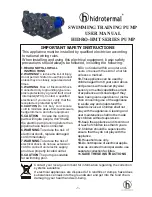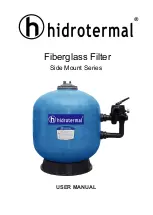
User Guide Oxymatic Basic
Rev.Apr 2013
Hydrover Water Solutions S..L.U.
13
4.
OXYMATIC START
4.1.
Preparation of treated water
Steps necessary for the initial treatment of water prior to the installation of the OXYMATIC ® system:
Water Balance
It is necessary for the pool water to be balanced to avoid incorrect disinfection, corrosion, precipitation of metal,
limestone, various staining and cloudy or green water. Regardless of the system used (chlorine, bromine,
oxygen, peroxide, ozone etc a pool must be balanced to the following parameters:
Calcium Hardness: 300-500 ppm.
Total Alkalinity: 100-175 ppm.
pH must be between 6.8 and 7.0.x
When water becomes unbalanced it becomes corrosive or scaled and considerably reduces the oxidizing agent
(Chlorine, Bromine, Oxygen, Peroxide, Ozone, Etc.) making disinfection at its minimum. Water flows
progressively, deteriorating the titanium electrodes, copper and other metal parts in the circuit of the water and
swimming pool.
In contrast, when the water is foul, stains and fouling can occur both in the glass of the pool and in the water
pipe circuit and the electrodes. This phenomenon may progressively deteriorate titanium electrodes and copper.
If the water of the swimming pool comes from a well:
Well water of this type is not as balanced as city tap water . It may contain different organisms, bacteria,
materials or heavy metals. In this case, the water needs an intensive preparation before the OXYMATIC system
is operational. The water must be completely free of metals, bacteria, etc..
Electrical conductivity or TDS (total dissolved solids):
The principle of OXYMATIC PLUS based on the hydrolysis determines the conductivity of the pool is an important
factor that favors the creation of ions (the higher the electrical conductivity or the amount of total solids
Dissolved in Water, TDS, the better). For proper operation of the system, the TDS should be above 600 ppm.
PARAMETERS BOARD OF A POOL
NOTE: If it is necessary to decrease the pH of the water, we recommend using sulfuric acid (38%) as pH reducer
instead of hydrochloric acid. This is because the hydrochloric acid also reduces the alkalinity, 2 / 10 while
reducing the pH of the water the same amount of hydrochloric acid. It is also safer than hydrochloric acid and
does not emit fumes or gases.
PARAMETER
RECOMMENDED
VALUE
INCREASE
DECREASE
Calcium hardness
(ppm)
300 - 500
Calcium Hardness Increaser
Calcium chloride (CaCl2)
20g/m3 up 15 ppm
¨not necessary¨
Total alkalinity
(ppm)
100 - 175
Alkalinity Increaser
Calcium carbonate (CaCO3):
1kg/50m3 increases 10 ppm.
Alkalinity Reducer
Hydrochloric acid (HCl) or
sodium bisulfite (NaHSO3)
TDS (total
dissolved solids)
(ppm)
+600
Common salt (NaCl): 100 ppm
increase 1.5kg/10m3
¨not necessary¨
pH
6.8 – 7.0
PH Increaser
Carbonate (NaCO3) or sodium
bicarbonate (Na (HCO3) 2)
PH Reducer
Sulfuric acid (H2SO4)
better than hydrochloric
acid (HCl)






































